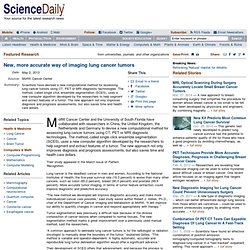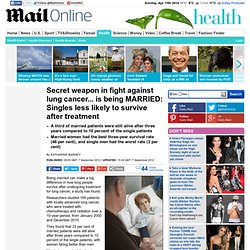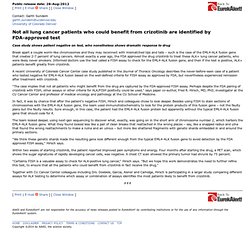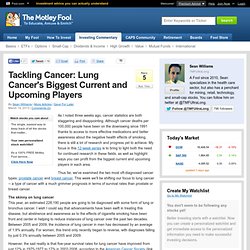

FDA approves GILOTRIF(TM) (afatinib) as first-line treatment for metastatic non-small cell lung cancer with common EGFR mutations. Inhaled chemo kills more lung tumors. RUTGERS (US) — Delivering chemotherapy through inhalation significantly improves the rate of successfully treating cancer tumors in the lungs, new animal studies show.

Lung cancer kills about 1.5 million men and women around the world—more than the number of people who die from breast, colon, pancreatic, and prostate cancers combined. Researchers say this happens, in part, because many patients with lung cancer are not diagnosed until they are in the advanced or metastatic stage of the disease and treatment options are limited mainly to surgery and conventional intravenous chemotherapy.
The new research indicates that inhalation therapy reduces systemic damage done to healthy lung cells and other organs while improving the treatment of lung tumors. “The development of additional more effective and safe approaches to treatment of this disease is vitally important,” says Tamara Minko, professor and chair of the department of pharmaceutics at Rutgers. Diabetes drug could help to combat lung cancer. New, more accurate way of imaging lung cancer tumors. Moffitt Cancer Center and the University of South Florida have collaborated with researchers in China, the United Kingdom, the Netherlands and Germany to devise a new computational method for assessing lung cancer tumors using CT, PET or MRI diagnostic technologies.

The method, called single click ensemble segmentation (SCES), uses a new computer algorithm developed by the researchers to help segment and extract features of a tumor. The new approach not only improves diagnosis and prognosis assessments, but also saves time and health care dollars. Their study appeared in the March issue of Pattern Recognition. Lung cancer is the deadliest cancer in men and women. According to the National Institutes of Health, the five-year survival rate (16.3 percent) is worse than many other cancers, such as colon (65.2 percent), breast (90.0 percent) and prostate (99.9 percent).
Their development of SCES offers that advancement, and because the process is automated, it requires less time and effort. Lung cancer: married patients are more likely to survive after treatment. A third of married patients were still alive after three years compared to 10 percent of the single patientsMarried women had the best three-year survival rate (46 per cent), and single men had the worst rate (3 per cent) By KATHARINE BARNEY Published: 09:55 GMT, 7 September 2012 | Updated: 15:24 GMT, 7 September 2012.

MedWire News - Oncology - Model predicts lung cancer risk. MedwireNews: Researchers have shown that The Liverpool Lung Project (LLP) Risk Model is effective in identifying those at the highest risk for lung cancer within 5 years, and who are therefore suitable for computed tomography (CT) screening.

The authors say that the model addresses major limitations in current predictive techniques, by combining five risk factors for lung cancer. "[The LLP Risk Model] unifies smoking duration, other important risk factors for lung cancer, and incidence data from cancer registries, thereby combining the benefit of each to provide accurate and diverse predicted risks for smokers and nonsmokers," write John Field (University of Liverpool, UK) and colleagues in the Annals of Internal Medicine.
The authors used two independent case-control studies and a population-based prospective cohort study to validate their model. Not all lung cancer patients who could benefit from crizotinib are identified by FDA-approved test. Public release date: 28-Aug-2012 [ Print | E-mail Share ] [ Close Window ] Contact: Garth Sundemgarth.sundem@ucdenver.edu University of Colorado Denver.

In lung cancer, smokers have 10 times more genetic damage than never-smokers. Lung cancer patients with a history of smoking have 10 times more genetic mutations in their tumors than those with the disease who have never smoked, according to a new study from Washington University School of Medicine in St.

Louis. "None of us were surprised that the genomes of smokers had more mutations than the genomes of never-smokers with lung cancer," says senior author Richard K. Wilson, PhD, director of The Genome Institute at Washington University. "But it was surprising to see 10-fold more mutations. It does reinforce the old message – don't smoke. " The study appears online Sept. 13 in Cell. Overall, the analysis identified about 3,700 mutations across all 17 patients with non-small cell lung cancer, the most common type. Lung cancer is divided into two types – small cell and non-small cell, the latter accounting for about 85 percent of all cases. This labeling is relevant, Wilson says, because today targeted therapies are approved based on the diseased organ or tissue. Tackling Cancer: Lung Cancer's Biggest Current and Upcoming Players (BMY, CELG, NVS, PFE, RHHBY)
As I noted three weeks ago, cancer statistics are both staggering and disappointing.

Although cancer deaths per 100,000 people have been on the downswing since 1991 thanks to access to more effective medications and better awareness about the negative health effects of smoking, there is still a lot of research and progress yet to achieve. My focus in this 12-week series is to bring to light both the need for continued research in these fields, as well as highlight ways you can profit from the biggest current and upcoming players in each area.